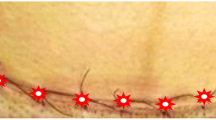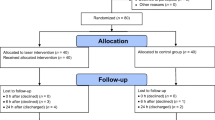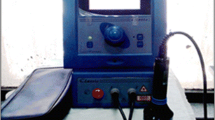Abstract
The effects of low-level laser on the wound healing and burn injuries have been previously examined to demonstrate some satisfactory results. Despite there are a few articles available to study photobiomodulation (PBM) effects on the pain relief of cesarean sectioned wound, however no systematic examination has been carried out so far regarding its healing. Here, the aim of this clinical study was to evaluate PBM effect on the cesarean-sectioned wound healing. PBM effects of semiconductor lasers are investigated at 658 and 660 nm with 100, 150 and 350 mW output powers on 40 patients. Due to the global increasing number of cesarean sections, we have decided to investigate the effect of laser as a reliable technique to recover the wounds fast. We considered women as the target group who had their first delivery giving the birth of their children by cesarean section. We selected patients are who treated by laser therapy using indium gallium aluminum phosphide (InGaAlP) semiconductor linear scanning type with beam cross section of 12 cm2 and the output power of 100 mW at 658 nm exposing a therapeutic dose of 2 J/cm2. The purpose is to accelerate the healing process of the wounds after delivery as an intervention group against the people who chose the conventional methods (using ointments, pills, etc.) to heal their cesarean sectioned wounds as the control group. Regarding the wounds of these two groups, the questionnaires were filled by patients to assess the severity of pain from visual analogue scale (VAS) based on the healing of wounds from redness, edema, ecchymosis, discharge, and distance between the two edges of the wound (REEDA) scale in the early hours after surgery and the post-treatment follow-up on the third, seventh, and the tenth days. The data collected by these questionnaires were analyzed using statistical package for social science)SPSS( as a statistical software to give out the comparative histograms. This study reports a clinical examination of PBM under intervention group of 40 patients ranging 18–40 years old with body mass index (BMI) of 29–36, during post-cesarean surgery to elucidate successful healing of the wounds and scars against conventional methods which considered as control group. Comparison of mean REEDA scores on the third day (p = 0.035), seventh day (p = 0.03), and tenth day (p = 0.02) after delivery exhibits that the two groups benefit a statistically significant difference with each other. For instance, the mean wound healing score in the intervention group was almost half of the mean wound healing score on the tenth day in the control group (1.09 ± 0.586 vs. 2.25 ± 0.422). The post-cesarean follow-up indicates that the patients treated by the laser therapy (intervention group) encounter better recovery than the control group.








Similar content being viewed by others
Data Availability
The corresponding author is able to send the data to the reader according to his/her request.
References
Mokmeli S, Khazemikho N, Niromanesh S, Vatankhah Z (2009) The application of low-level laser therapy after cesarean section does not compromise blood prolactin levels and lactation status. Photomed Laser Surg 27(3):509–512
de Holanda AAMP, de Sena KRR, da Silva FEM, Pegado R, Micussi MTABC (2020) Low-level laser therapy improves pain in postcesarean section: a randomized clinical trial. Lasers Med Sci 35(5):1095–1102
Poursalehan S, Nesioonpour S, Akhondzadeh R, Mokmeli S (2018) The effect of low-level laser on postoperative pain after elective cesarean section. Anesth Pain Med 8(6):e84195
Hamblin M, Demidova T (2006) Mechanisms of low level light therapy. Proc of SPIE 6140:614001
Hamblin M (2016) Photobiomodulation or low-level laser therapy. J Biophotonics 9(11–12):1122–1124
Parvin P, Eftekharnoori S, Dehghanpour HR (2009) Monte Carlo simulation of photon densities inside the dermis in LLLT (Low Level Laser Therapy). Opt Spectrosc 107(3):489
Nakashima T, Ueda H, Misawa H, Suzuki T, Tominaga M, Ito A, Numata S, Kasai S, Asahi K, Vernon JA, Meikle MB (2002) Transmeatal low-power laser irradiation for tinnitus. Otol Neurotol 23(3):296–300
Rocha Júnior AM, Vieira BJ, Andrade LCFd, Aarestrup FM (2007) Effects of low-level laser therapy on the progress of wound healing in humans: the contribution of in vitro and in vivo experimentalstudies. J Vasc Bras 6(3):257–265
Hopkins JT, Mcloda TY, Seegmiller JG, Baxter GD (2004) Low level laser therapy facilitates super ficial wound healing in human: a tripl -blind, sham controlled study. J Athl Train 39(3):223–229
Simunovic Z, Ivankovich AD, Depolo A (2000) Wound healing of animal and human body sport and traffic accident injuries using low-level laser therapy treatment: a randomized clinical study of seventy-four patients with control group. J Clin Laser Med Surg 18(2):67–73
Al-Watban FAH, Zhang XY, Andres BL (2007) Low-level laser therapy enhances wound healing in diabetic rats: a comparison of different lasers. Photomed Laser Surg 25(2):72–77
Bisht D, Gupta SC, Misra V (1994) Effect of low intensity laser radiation on healing of open skin wounds in rats. Indian J Mec Res 100:43–46
Pereira AN, Eduardo CDP, Matsone E, Marques MM (2002) Effect of low _ power laserirradiation on cell growth & procollagen synthesis of cultured fibroblast. Laser Surg & Med 31:263–267
Demir H, Balay H, Kirnap M (2004) A comparative study of the effects of electrical stimulation & laser treatment on experimental wound healing in rats. J Rehabil Res Dev 41:147–154
Bayat M, Azari A, Golmohammadi MG (2010) Effects of 780-nm low-level laser therapy with a pulsed gallium aluminum arsenide laser on the healing of surgically induced open skin wound of rat. Photomed Laser Surg 28(4):465–470
Reddy G (2003) Comparison of the photostimulatory effects of visible He-Ne and infrared Ga-As lasers on healing impaired diabetic rat wounds. Lasers Surg Med 33(5):344–351
Stadler I, Lanzafame RJ, Evans R, Narayan V, Dailey B, Buehner N, Naim JO (2001) 830nm irradiation increases the wound tensile strength in a diabetic murine model. Lasers Surg Med 28(3):220–226
Abergel RP, Lyons RF, White RA, Dwyer RM, Castel JC, Uitto J (1987) Biostimulation of wound healing in vivo by a helium-neon laser. Ann Plast Surg 18:47–50
Yasukawa A, Hrui H, Koyama Y, Nagai M, Takakuda K (2007) The effect of low reactive-level laser therapy (LLLT) with helium-neon laser on operative wound healing in a rat model. J Vet Med Sci 69(8):799–806
Hosseini Sanati M, Torkaman G, Hedayati M, Mokhtari M (2010) Effect of Ga-As (904nm) and He- Ne (632 8nm) laser on the improvement of biomechanical characteristics recovery in full Thickness wound. Lasers Med 7(1):6–13
Carvalho PdTCd, Mazzer N, Reis FAd, Belchior ACG, Silva IS (2006) Analysis of the influence of low-power HeNe laser on the healing of skin wounds in diabetic and non-diabetic rats. Acta Cir Bras 21(3):177–183
Ilkeuchi S, Ohsaka F, Asanami A, Nomoto T (1989) Effects of low power He-Ne laser on the healing of full-thickness skin defects. Laser Dent 2:85–89
Moulin V, Auger FA, Garrel D, Germain L (2000) Role of wound healing myofibroblasts on reepithelialization of human skin. Burns 26:2–12
Pereira AN, Eduardo Cde P, Matson E, Marques MM (2002) Effect of low-power laser irradiation on cell growth and procollagen synthesis of cultured fibroblasts. Lasers Surg Med 31:263–267
Young S, Bolton P, Dyson M, Harvey W, Diamantopoulos C (1989) Macrophage responsiveness to light therapy. Lasers Surg Med 9:497–505
Fujimaki Y, Shimoyama T, Liu Q, Umeda T, Nakaji S, Sugawara K (2003) Low-level laser irradiation attenuates production of reactive oxygen species by human neutrophils. J Clin Laser Med Surg 21:165–170
Chen YS, Hsu SF, Chiu CW, Lin JG, Chen CT, Yao CH (2005) Effect of low-power pulsed laser on peripheral nerve regeneration in rats. Microsurgery 25:83–89
Miloro M, Halkias LE, Mallery S, Travers S, Rashid RG (2002) Low-level laser effect on neural regeneration in Gore-Tex tubes. Oral Surg. Oral Med. Oral Pathol Oral Radiol Endod 93:27–34
Balaban P, Esenaliev R, Karu T, Kutomkina E, Letokhov V, Oraevsky A, Ovcharenko N (1992) He-Ne laser irradiation of single identified neurons, Lasers Surg. Med 12:329–337
Neimz M (2007) Laser-tissue interactions. Springer, Berlin
Acknowledgements
We are very interested to express our thanks and appreciation for the help of Dr. Afshin Kazerouni and Dr. Elahe Mollasalehi, from the staff of Sarem obstetrics and gynecology hospital, for helpful technical consults. We are very grateful to the expertized nurse Masoumeh Mardani for performing laser therapy and blind assessment of patients.
Author information
Authors and Affiliations
Contributions
Conceptualization: Hamid Reza Deghanpour; Methodology: Hamid Reaz Dehghanpour, Aliakbar Golchini; Clinical affairs: Parvaneh Ganjali, Aliakbar Golchini; Software: Parvaneh Gnajali, Omid Heidari; Validation: Hamid Reza Dehghanpour; Formal analysis: Hamid Reza Dehghanpour, Aliakbar Golchini; Investigation: Hamid Reza Dehghanpour, Aliakbar Golchini; Data curation: Parvaneh Ganjali; writing—original draft preparation: Hamid Reza Dehghanpour; Writing—review and editing: Hamid Reza Dehghanpour, Parviz Parvin, Hossein Eshghifard; Visualization: Hamid Reza Dehghanpour, Parvaneh Ganjali; Supervision, Hamid Reza Dehghanpour; Project administration: Hamid Reza Dehghanpour and Aliakbar Golchini.
Corresponding author
Ethics declarations
Conflict of interest
The authors declare no competing interests.
Additional information
Publisher's note
Springer Nature remains neutral with regard to jurisdictional claims in published maps and institutional affiliations.
Appendices
Appendix 1

Appendix 2


Rights and permissions
Springer Nature or its licensor (e.g. a society or other partner) holds exclusive rights to this article under a publishing agreement with the author(s) or other rightsholder(s); author self-archiving of the accepted manuscript version of this article is solely governed by the terms of such publishing agreement and applicable law.
About this article
Cite this article
Dehghanpour, H.R., Parvin, P., Ganjali, P. et al. Evaluation of photobiomodulation effect on cesarean-sectioned wound healing: a clinical study. Lasers Med Sci 38, 171 (2023). https://doi.org/10.1007/s10103-023-03774-6
Received:
Accepted:
Published:
DOI: https://doi.org/10.1007/s10103-023-03774-6




